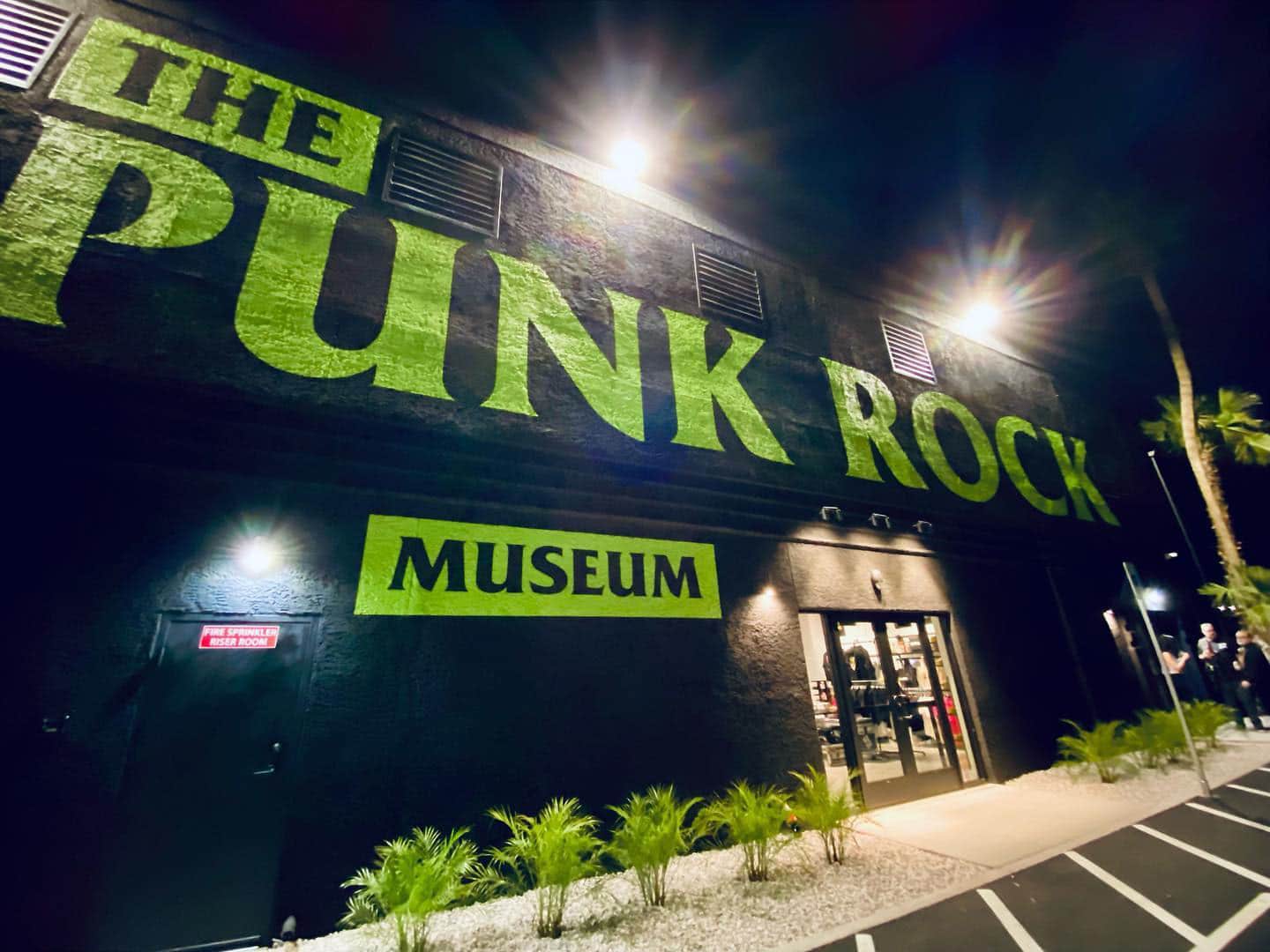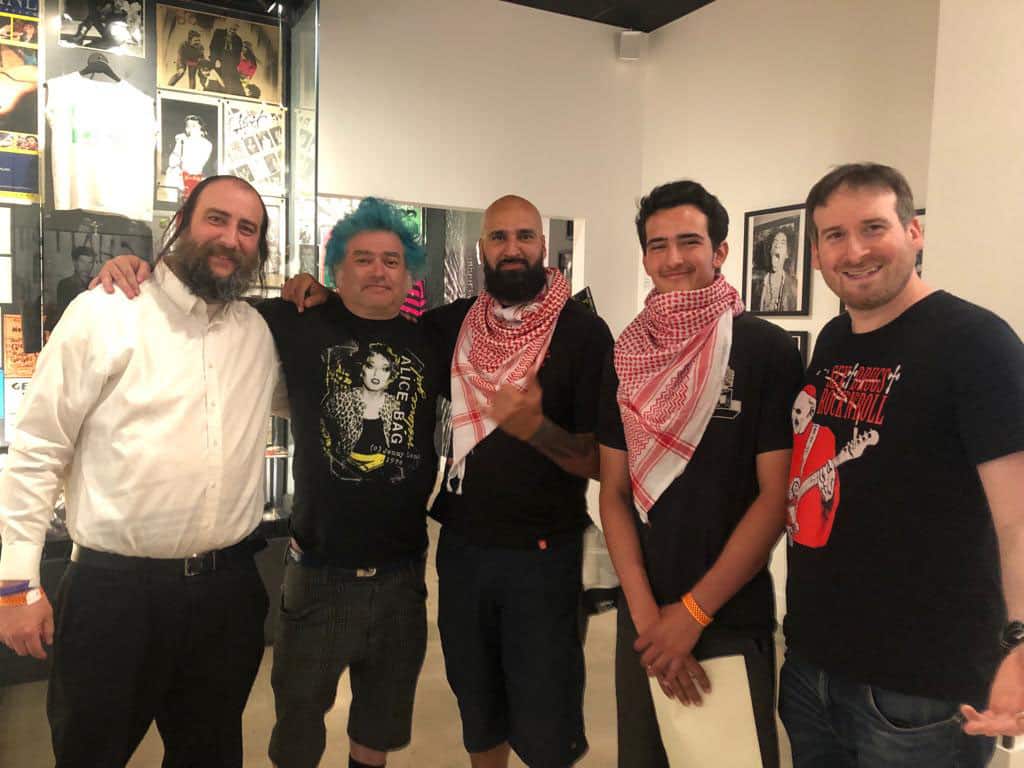 Photo by Lisa Johnson
Photo by Lisa Johnson One of the many Jews who have been a pillar of the punk rock music scene is Mike Burkett, aka Fat Mike, the singer and bassist of the band NOFX and owner of the record label Fat Wreck Chords. In April of this year, he opened The Punk Rock Museum in Las Vegas. It would have been natural for the museum to be located in New York, Los Angeles or Oakland, the cities where punk first took hold, but the real estate costs were simply too high. “Vegas is also the most punk city in the country”, Mike told the Journal. “It plays by its own rules.”
Fat Mike took the Journal on an exclusive tour of The Punk Rock Museum — and was apt to point out every Jewish-related artifact and musician, a group which includes Lou Reed, Joey and Tommy Ramone, Bad Religion‘s Brett Gurewitzand Greg Hetson. “I wanted everyone to feel comfortable coming to this museum,” he told the Journal. The lobby is a stark, modern-industrial space — black walls with oversized black-and-white photos. The rest of the rooms are packed floor-to-ceiling with memorabilia: Posters, crude, Xeroxed leaflets announcing gigs bands would wheat-glue onto utility poles and walls, albums, picture sleeves for singles, instruments, tee-shirts and more. They’re a testament to the punk scene’s tenets of inclusiveness and do-it-yourself style.
Throughout the tour, Fat Mike would unlock exhibits to adjust artifacts and add his collection of LPs. The first exhibit he adjusted was a tiny bag with what looked like dirt. It was the last bag of weed from the late Joe Strummer of The Clash. “Do you see the problem?” Fat Mike asked. “It’s poorly lit!” He opened the exhibit door and adjusted the spotlight with his bare fingers, letting out several audible screams. “Look how much better that is!”
The number of bands included in the museum is overwhelming. You’ll see collections of the now defunct Maximum Rocknroll magazine, a couch used by Kurt Cobain from Nirvana, L.A. Punk pioneer Darby Crash’s (The Germs) phone book, Billie Joe Armstrong’s (Green Day) first amplifier, the shirt the late Joe Strummer wore at his last performance. There’s a letter from a 15-year-old Dave Grohl of the Foo Fighters wrote to Necros — the Detroit hardcore band — asking for stickers and for them to play in his home town of Washington, DC. There’s original concert posters from Motörhead, a shirt from Iggy Pop’s 1977 tour, and an astounding amount of setlists and handwritten lyrics.
Two years ago, Fat Mike put out a call to all punk musicians to donate their own artifacts that might be rotting away in their garages or storage lockers. “If you want to see something, send it,” Fat Mike said. “We reached out to as many people as we could and a lot of people just didn’t send stuff. They didn’t really believe we were opening.” The band Pennywise donated tons of equipment from their Hermosa Beach rehearsal space they used in the early 1990s. They donated so much that the old rehearsal space itself was fully-recreated at the museum. The instruments are plugged in too, for future mini concerts.
One feature that sets the museum apart is the extensive lineup of punk musicians who will act as tour guides. In May, the punk docents included Greg Hetson, Strung Out frontman Jason Cruz, and Chris Demakes from Less Than Jake. This month included Marko DeSantis from Sugarcult and Jack Grisham from T.S.O.L. In July, visitors can get tours from Dave Baksh from Sum 41, Jonny Wickersham from Social Distortion and Stacey Dee from Bad Cop/Bad Cop. The July 23rd tours led by drummer, actor and Grammy-nominated comedian Fred Armisen sold out in mere minutes. The lineup changes daily, depending on who is in town. Since the museum’s opening this spring, there have been surprise visits from Flea of the Red Hot Chili Peppers, Dexter Holland and Noodles Wasserman of The Offspring and skateboarding legend Tony Hawk.
There is even a jam room where fans can plug in and play some of their musical heroes’ instruments — among them, Joan Jett’s guitar and the late Wesley Willis’ keyboard. There is no rule forbidding visitors from jamming an overplayed song — they can even play “Stairway to Heaven” if they want. The room is closely watched — both to make sure no one walks out with a valuable guitar, but also so no one decides to imitate the cover of the Clash’s “London Calling” and smash a guitar.
At one point on our tour, Fat Mike noticed a father and son, Omar Muniser Sr. and Omar Muniser Jr., both wearing keffiyeh around their necks. They reside in San Bernardino County where play in the punk duo Paint The Town Rad. “I’m doing an interview with the Jewish Journal right now, and f–kin’ hanging out with the Muslims!” Fat Mike quipped. “Jews, meet the Muslims. Muslims, meet the Jews.” It turned into 30 minute conversation about cycles of intergenerational hatred and abuse, squabbles with lovers and friends, and Fat Mike’s geopolitical observations from touring the world for nearly 40 years with NOFX. We talked about Middle Eastern food and customs and then Fat Mike regaled the story of his first visit to Israel as a teenager. “Yeah, my dad tried leaving me at a kibbutz,” he said. Fat Mike dared the younger Omar to go to a telephone pole displayed in the museum with replica concert fliers stapled to it. When Omar Jr. finally ripped off a flier, Fat Mike yelled, “He’s taking shit from the museum!” Ripping the flyers is actually encouraged.

The Punk Rock Museum has much more than history. It encourages a communal feel where visitors are encouraged to meet each other. There’s a bar called the Triple Down where you can get several musician-concocted drinks, including one served in an empty Pringles bottle. There’s outdoor picnic tables with views of the Stratosphere Tower. On the museum’s second floor, there’s a chapel for punk fans to get married. There’s even a tattoo shop.
“Music transcends and brings people together on so many levels,” Maya Hendler, who was visiting the museum, told the Journal. “Go to a punk concert, everyone’s in a mosh pit together. The bigger people look out for the smaller people. Being the smaller girl, I’d always found a bigger guy that would look after me. It’s a community.” Maya brought her husband Omer to the museum as a birthday gift. “The preconceptions that you have about people who you are not normally around or you don’t know, that all goes away with music because music is real,” Omer told the Journal. His friend Dovid then texted him the metaphor of the day: “Jews are the original punk rockers. Social outcasts, our mission shunned by mainstream society and a constant source of inspiration for those involved, while staying a target for those outside the fold. The metaphor continues…”
“Jews are the original punk rockers. Social outcasts, our mission shunned by mainstream society and a constant source of inspiration for those involved, while staying a target for those outside the fold.”
As we parted ways, Fat Mike said to me, “Man wasn’t that fun? Today was the most fun I’ve had here so far.” There’s no guarantee that Fat Mike will be there when you visit, but there is no doubt that there will be visitors from the punk community celebrating the music they love.























 More news and opinions than at a Shabbat dinner, right in your inbox.
More news and opinions than at a Shabbat dinner, right in your inbox.